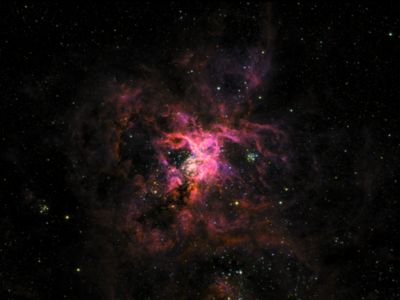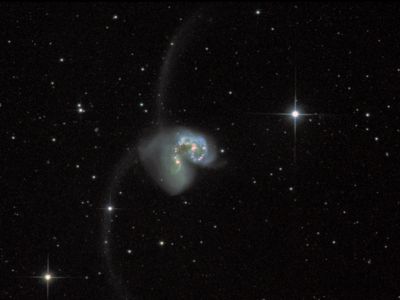Groundbreaking Balloon-Based Telescope Offers New Insights Into Dark Matter
The Super Pressure Balloon Imaging Telescope (SuperBIT) has taken its first images of the cosmos from the edge of space.
Astronomers are hoping to gain valuable data that could help unravel the mysteries surrounding dark matter.
On April 16, the stratospheric observer was carried to a high altitude above Earth’s atmosphere by a football field-sized NASA helium balloon in its first operational flight.

During the flight, SuperBIT captured images of the Tarantula Nebula, a region within the Large Magellanic Cloud, which is a satellite galaxy of the Milky Way located approximately 160,000 light-years from Earth. This immense cloud of gas and dust, spanning 931 light-years, is a hotbed of star formation. The telescope also obtained images of the Antennae galaxies, NGC 4038 and NGC 4039, which are located around 60 million light-years away in the southern constellation of Corvus. These galaxies are currently experiencing a collision and merger that likely began a few hundred million years ago, making them the closest and youngest examples of colliding galaxies.
SuperBIT’s primary goal is to capture images of galaxies in the visible-to-near ultraviolet light spectrum. Although the Hubble Space Telescope covers this range, SuperBIT offers a wider field of view. To study dark matter, the telescope will utilize gravitational lensing, a natural phenomenon predicted by Einstein’s theory of general relativity. Gravitational lensing occurs when massive objects like galaxies warp spacetime, causing light to bend as it travels along the curvature.
Dark matter, which does not interact with electromagnetic radiation or light, is virtually invisible. However, it does interact with gravity, allowing astronomers to infer its presence. Gravitational lensing is an ideal method for mapping dark matter’s distribution, and SuperBIT may help scientists determine whether dark matter particles can bounce off one another when galactic clusters collide. Such research could finally reveal the composition of dark matter particles.
Professor Richard Massey from Durham University explained that SuperBIT would observe clusters of galaxies colliding with each other. He stated, “Essentially, we’re using the largest particle accelerators in the universe to smash lumps of dark matter and see where the bits fly.” He added, “If dark matter goes ‘crunch’, or if bits are chipped off, we could finally start to learn what it’s made of.”

SuperBIT, a collaboration between NASA, Durham University, the University of Toronto, and Princeton University, launched from Wānaka, New Zealand. The telescope and its super-pressure balloon can travel around the globe at an altitude of approximately 21 miles (34 kilometers) for 100 days, above 99.5% of Earth’s atmosphere. This vantage point enables SuperBIT to gather scientific data and take high-resolution images without the blurring effect of the atmosphere.
The telescope can be safely returned to Earth via parachute, allowing the team to update its design. Funding has already been secured to upgrade SuperBIT’s 1.6 feet (0.5-meter) aperture telescope to 5.2 feet (1.6 meters), equipping it with a wider-angle lens and increased megapixels for the camera. This enhancement will increase its light-gathering power tenfold.
With a price tag of approximately $5 million, the balloon-carried telescope represents a significantly more economical option compared to rocket-launched instruments. In fact, SuperBIT costs almost 1,000 times less than equivalent satellite missions. NASA officials envision that the relatively low cost of SuperBIT could pave the way for a fleet of these telescopes to be deployed above Earth, collectively exploring the enigmas of the universe with greater affordability and accessibility.
READ MORE
-
India Successfully Lands Spacecraft on Moon’s South Pole
India achieves a historic milestone by successfully landing Chandrayaan-3 spacecraft on the moon's south pole, marking the nation's ascent to lunar exploration. Learn about the significance of this achievement and its implications for space exploration.Read More -
Timber in Orbit: Japan’s Wooden Satellite Prepares for Launch
In a groundbreaking endeavor, Japanese researchers are challenging conventions by showcasing the unexpected resilience of wood in the hostile environment of outer space. This extraordinary feat raises an intriguing question: could wooden satellites hold the key to a sustainable future for space technology?Read More -
Seradata Welcomes Melissa Quinn: New Horizons with EVONA
Breaking: Melissa Quinn's new role unveiled - placed by EVONA. Discover her transformative journey from Spaceport Cornwall to Seradata.Read More